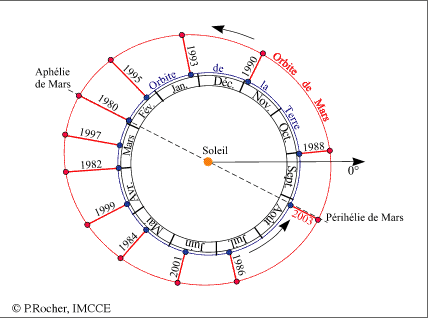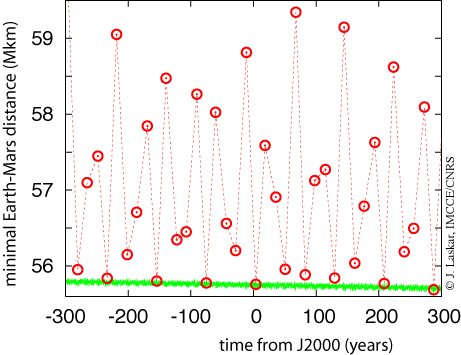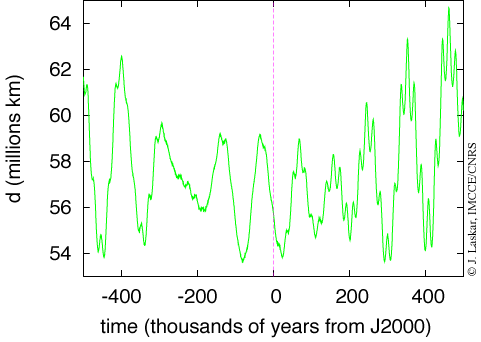Primer on Mars oppositions
This page is available in French
Mars opposition
The opposition of Mars is the moment when the geocentric longitude of Mars (counted on the ecliptic of the date) is contrary to the geocentric longitude of the Sun.
If the orbits of two planets were circular, this moment would be also a minimum of distance between two planets. As the orbits slightly eccentric and are inclined, the date of the minimum of distance can differ from it from a few days.
Example (IMCCE data) :
- On 27/08/2003 at 09h 51m 14s UT : the Earth-Mars distance is minimal.
- On 28/08/2003 at 17h 58m 49s UT : Mars is in opposition.
Duration between two oppositions:
The mean angular (sideral) velocity of the Earth is $n_1 = 6.28307585$ radians/yr, and for Mars $n_2 = 3.34061243$ radians/yr. If we start at an opposition, the next one occurs when the Earth catch up with Mars, making one additional lap over the Sun, that is
$$ n_1 t = n_2 t + 2 \pi $$
thus, after (in years)
$t_1 = 2 \pi/(n_1-n_2)$
which can be converted in number of revolutions (so practically in years)
nopp $= t_1/T_1=n_1/(n_1-n_2) = 2.135311456$
The next opposition will thus occur in a little bit more than 2 years and 49 days.
Earth-Mars distance at opposition
If the orbit of the Earth and Mars were circular and coplanar, the Earth-Mars distance at opposition would be constant and equal to the difference of their semi-major axis, that is dmin ~ 1.524 - 1.000 = 0.524 au (astronomical unit ~150 million of km (Mkm)). As it is not the case, this distance to the oppositions will vary from one opposition to another. As the eccentricity of Mars is dominant, the minimal distance will be obtained in the vicinity of the perihelion of Mars (minimal Sun-Mars distance).

Fig.1: Configurations of the oppositions of Mars between 1980 and 2003
Minimal Earth-Mars distances in the vicinity of the recent oppositions.
| date | Earth-Mars (au) | distance (Mkm) | Mars apparent |
|---|---|---|---|
| 26 february 1980 | 0.677310 | 101.324 | 13.83” |
| 5 april 1982 | 0.635114 | 95.012 | 14.75” |
| 19 may 1984 | 0.531461 | 79.505 | 17.63” |
| 16 july 1986 | 0.403568 | 60.373 | 23.21” |
| 22 september 1988 | 0.393147 | 58.814 | 23.83” |
| 20 november 1990 | 0.516922 | 77.330 | 18.12” |
| 3 january 1993 | 0.626093 | 93.662 | 14.96” |
| 11 february 1995 | 0.675694 | 101.082 | 13.86” |
| 20 march 1997 | 0.659382 | 98.642 | 14.21” |
| 1 may 1999 | 0.578463 | 86.537 | 16.19” |
| 21 june 2001 | 0.450167 | 67.344 | 20.81” |
| 27 august 2003 | 0.372719 | 55.758 | 25.13” |
| 30 october 2005 | 0.464063 | 69.423 | 20.19” |
Favorable oppositions
From a favorable opposition, i.e. an opposition taking place at least distance between the orbit of the Earth and Mars (as it will be about the case on August 27, 2003), one will return to the same configuration when, after a whole number N of oppositions, the Earth will have carried out a whole number of turns, that is to say when
N *nopp is close to an integer value.
We thus search for the rational approximations M/N of nopp, which is easily done with the continuous fraction expansion of nopp
nopp ~ 2+1/(7+1/(2+1/(1+1/(1+1/(3+1/(1))))));
which successive rational approximants are
- aa1 = 2 + 1/7 = 15/7 = 2.14285714285714
- aa2 = 2 + 2/15 = 32/15 = 2.13333333333333
- aa3 = 2 + 3/22 = 47/22 = 2.13636363636364
- aa4 = 2 + 5/37 = 79/37 = 2.13513513513514
- aa5 = 2 + 18/133 = 284/133 = 2.13533834586466
- aa6 = 2 + 23/170 = 363/170 = 2.13529411764706
There will be thus a favorable opposition every approximately 15 years, after 7 oppositions, but one will approach the starting configuration still better every 32 years, 47 years, 79 years, 284 years, or 363 years. Of course these calculations are approximate, because they do not take account of the deformation of the orbits.
Earth-Mars distance at favorable oppositions.
The favorable oppositions take place every approximately 15 years, but the minimal geometrical distance between the two orbits is reached with this favorable opposition only when the two planets are very close to this optimal position at the time of the opposition.

Fig.2 : Minimal Earth-Mars distance with the most favorable oppositions, of -300 at + 300 years from January 1, 2000 to 12 H (J2000) (red circles). The green curve is the minimal distance between the orbit of the Earth and Mars (thus the minimal distance enters the two ellipses).
Earth-Mars distance evolution over 1 million years.
Because of the perturbations of other planets, the orbits of the Earth and Mars become deformed slowly in time and precesse slowly in their plane and in space. The configuration of the two orbits thus evolves, and the minimal Earth-Mars distance too. Practically, the minimum of distance will take place when the eccentricity of Mars is maximum. As we saw above, the minimal distance from the two orbits is not always carried out with the oppositions, but one can consider that this minimum is roughly reached over 100 years (see figure 2). Over a long duration, one can thus be satisfied to calculate the minimal distances between the two orbits, without explicitly seeking the dates of the favorable oppositions which will achieve (almost) these minima (fig. 3).

Fig.3: : Minimal distance (D_TM) between the two orbits of the Earth and Mars from -500 000 to + 500 000 years since J2000, in million km
Remarkable dates
On a few thousands of years around the current date, the minimal Earth-Mars distance decreases (fig. 3). It was thus larger in the past, and will be smaller in the future. But this minimal distance is carried out only very approximativemnt during the oppositions. The principal characteristic of the opposition of August 2003 is to achieve this minimal distance with a very good approximation, which occurs only all the 79 or 284 years. In the past, there was a very good realization of this minimum 79 years ago, in August 1924, but as the minimal distance between the orbits of the Earth and Mars was larger, this minimum is larger than the minimum of August 27, 2003. To find an equivalent Eart-Mars distance, it is necessary to go much further in the past, when the eccentricity of Mars was larger, 59 618 years ago (the 73 000 years value often quoted corresponds to a crude approximation). In the next millenium, as the minimal distance between the orbits of the Earth and Mars decrease, one will find many oppositions with a Earth-Mars distance closer than that of August 27, but the first will take place only in 284 years, dates to which this minimum will be almost achieved at the time of a favorable opposition (Fig.2).
Minimal distances of the oppositions from -300 to + 300 with respect to J2000 Only minimal distances lower than 56 Mkm are given (computations from ASD/IMCCE, Observatoire of Paris)
| date | Earth-Mars (ua) | distance (Mkm) | apparent Mars diameter |
|---|---|---|---|
| 25 august 1719 | 0.374010 | 55.951 | 25.05” |
| 13 august 1766 | 0.373260 | 55.839 | 25.10” |
| 18 august 1845 | 0.373021 | 55.803 | 25.11” |
| 22 august 1924 | 0.372846 | 55.777 | 25.12” |
| 27 august 2003 | 0.372719 | 55.758 | 25.13” |
| 15 august 2050 | 0.374051 | 55.957 | 25.04” |
| 30 august 2082 | 0.373564 | 55.884 | 25.08” |
| 19 august 2129 | 0.373276 | 55.841 | 25.10” |
| 24 august 2208 | 0.372794 | 55.769 | 25.13” |
| 28 august 2287 | 0.372254 | 55.688 | 25.16” |
The numerical integrations carried out over 500 000 years (ASD/IMCCE) also make it possible to specify the following dates:
Last opposition where the Earth-Mars distance was smaller than that of August 27, 2003:
59 615.267 years before J2000, d_TM = 0.372452 au (55.718 Mkm), Mars apparent diameter : 25.15”.
On the other hand, while looking at even further, one will find values of the Earth-Mars distance even smaller, with a minimum in the last 500 000 years in
80 955.939 years before J2000,d_TM = 0.358739 au (53.667 Mkm), Mars apparent diameter : 26.11”.
Next the grand minimum will take place (Fig.3)
23 695.342years after J2000, d_TM = 0.359769 au (53.821 Mkm), Mars apparent diameter : 26.04”.
and the absolute minimum in next the 500 000 years will take place
292 851.722 years after J2000, d_TM = 0.358541 au (53.637 Mkm), Mars apparent diameter : 26.13”.
© J. Laskar, IMCCE/CNRS, Observatoire de Paris, (last revision 14 août 2003)